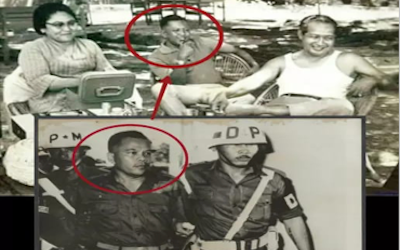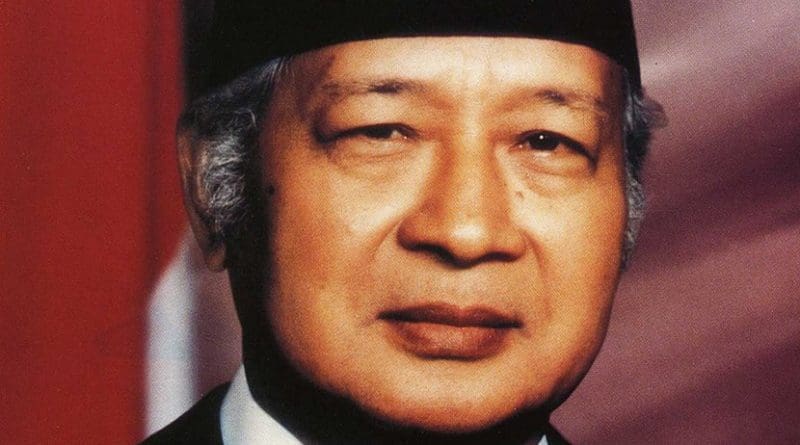Revisiting Suharto And The September 30 Movement -OpEd
‘Murder Will Out’: Suharto 1965
During my ten days in Jakarta in May 1998 when the Suharto era ended, I visited Cipinang penitentiary to speak with Colonel Abdul Latief. He’d been in prison since 1965 for the entire Suharto era, the ‘New Order’. Latief had helped start the ‘September 30 Movement’ which went beyond his control and led to six generals being murdered instead of kidnapped. Latief’s good friend, Major-General Suharto, became president of Indonesia, although previously he was part of the ‘Movement’. Suharto blamed the Indonesian communist party for the death of the generals and embarked on one of the worst mass-killings in the 20th century.
According to army protocol in 1965, if the head of the army, General Yani, disappeared – not killed but missing, such as kidnapped – Yani was to be replaced by a Lieutenant General, a staff officer not in command of troops but higher than Major-General. In the event of Yani’s death, however, his replacement would be Suharto who was in command of troops. Suharto was the first-ever head of Kostrad – strategic command troops in operational readiness.
The death of Yani opened the door for Suharto to become head of the army, and Suharto seized the top position mid-morning on 1st October, even before the death of Yani was confirmed. He overruled President Sukarno’s request for a different general to head the army.
On 4th October, British Ambassador Gilchrist informed the Foreign Office [FO 371 180317] that it “is still difficult to determine the degree of participation of the PKI (communist) leaders. On 5th, the bodies of the slain generals were recovered and Suharto referred to the “atrocities perpetrated by barbarous adventurers” on the murdered generals. He said “they had been tortured” by communist women. The autopsy report refuted Suharto’s claims but he refused Sukarno permission to make the report public. Gilchrist informed London his intention was to “play up communist participation and repeatedly emphasize horrible mutilation of army generals”, a brutality reminiscent of “Madiun in 1948”, he added.
Right from the start of the ‘Movement’, there were anomalies implicating Suharto. On the night of 30th September, several buildings like telecommunications, close to Kostrad, were occupied by the thousand or so troops in the ‘Movement’, but not Kostrad. Nor was Suharto himself on the list to be kidnapped. Some commentators have suggested this occurred because the Movement was so badly organized. The simple answer is: up to mid-afternoon, October 1, 1965, Suharto was regarded as part of the ‘Movement’. Troops from the ‘Movement’ occupying adjacent Merdeka Square, even walked in and out of Kostrad to use the toilet facilities.
When I spoke with Latief after three decades in prison, it was obvious to him that his friend, the Kostrad commander, had used the ‘Movement’ as a political catalyst. Latief told me that he had explained to the military court, after waiting 13 years to be brought to trial, Suharto himself was in the ‘Movement’. “Suharto was one of us,” he declared. By 1978 Suharto was well-ensconced in the presidency and it was clear to Latief his friend had used his inside-position in the ‘Movement’ to pervert the intended kidnapping to killing, with the help of his top intelligence officer, Ali Murtopo, later known as ‘architect of the New Order’.
There will be no historical closure of 1965 until Suharto’s links are clarified, not only with Colonel Abdul Latief but also with other members of the ‘Movement’, such as Lieutenant Colonel Untung and Kamaruzzaman, (aka ‘Sjam’) the civilian appointed by the head of the Indonesian communist party (PKI), D. N. Aidit.

After serving under Suharto in Central Java, Untung was the ‘star soldier’. In British embassy records, Untung was described as “tough…[but] not overly bright” and right up to the time of his execution, Untung believed his friend Suharto would intervene to save his life. Latief had no such illusions. In his first year of imprisonment he ate rats to stay alive after being shot in the knee, bayoneted in the thigh and left for dead in the cell. The precept underlying all military-run trials relating to 1965 was Suharto’s accusation of PKI involvement – supported by Sjam – so when Latief’s trial was finally held in 1978, his ‘evidence’ of Suharto’s involvement was deemed irrelevant.
Foreign Minister Subandrio was also imprisoned by Suharto and upon his release in 1996 wrote (Kesaksianku Tentang G30S, p.30) that Suharto was “a fascist dressed in Javanese feudal refinement”. Both Subandrio and General Nasution (whom I spoke with over a period of 13 years) accused Suharto of involvement in killing the generals.
Untung and Latief were greatly impressed by Suharto’s lifestyle, practising kebatinan (Javanese mystic religion) rather than the flamboyance of General Yani, who drove around Jakarta in his grand white Lincoln automobile. When Suharto attended the wedding of Untung in Central Java, it was a great honour to have a major-general attend, but in retrospect it would seem that Suharto was ‘grooming’ Untung. This was how Suharto gained the strategic advantage of being “one of us”. He was on the inside of the ‘Movement’ at the crucial time. Similar to the inner-self which is a Hindu-Buddhist element of kebatinan, Suharto had an inner core quite distinct from external appearances which for all intents and purposes made him seem politically ‘middle of the road’. Suharto’s inner self was rarely seen, but General Nasution brought an incident to my attention. Suharto and Sjam were seen together visiting the ‘officer training institution’ in Bandung, headed by Suwarto, whom Nasution plainly described as “CIA”. Suharto had studied there, so a visit might be on the cards, but going with Sjam created a new paradigm of treason.
Neither Untung nor Latief realized that the primary identity of Sjam, as a link with Aidit, was actually covering his longer-term links with Suharto. Sjam’s ID gave him access to Kostrad headquarters where ostensibly he could ascertain those officers who were ‘progressive’ (ie. not anti-PKI). In reality, it provided Sjam contact with Suharto and his top two in intelligence, Ali Murtopo and Yoga Sugama. Sjam and Suharto had been associates since the days of the independence struggle against the Dutch, 1945-1949, and remained in contact when Suharto was commander of Diponegoro Division in Central Java, 1956-59.
Another clear link between Sjam and Suharto, momentarily exposing his inner-self, occurred just after 7am on the morning of 1st October 1965. As Suharto strode into Kostrad headquarters, Ali Murtopo was waiting for him and Suharto asked: “Where is Sjam?”
Perhaps Suharto was mentally burdened by all the trauma that had occurred, on which so much depended. He was overheard by Kostrad chief of staff, Brigadier-General Josef Muskita but not revealed for many years. It was finally reported by respected journalist Aristides Katoppo at a conference in Canberra in 2015, ‘1965 and the Indonesian Coup: 50 years on’.
Katoppo expounded on the Suharto-Sjam link with further details about the arrest of Sjam in Bandung. He had eluded capture for three years after the killing of the generals. The Indonesian officer who located Sjam was head of counter-intelligence. He followed normal procedure and notified his superior who, in turn, notified Suharto that the arrest of Sjam was imminent. Sjam was to be collected at 6am, but when the arresting officer arrived at the location Sjam was already gone. And when Sjam’s new hiding-place was located, the same time was set for arrest, 6am, but with the same outcome. Sjam had fled. The arresting officer suspected that Sjam had been notified by Suharto so when a 6am arrest was set a third time, he moved straightaway to Sjam’s location and arrested him immediately.
Katoppo was given photographs of Sjam that showed his exact location with street signs and the date, because the arresting officer was now fearful that arresting Sjam might result in retribution by Suharto. But after explaining his actions to Suharto, with details of the arrest, nothing happened. A year later, however, he was arrested on a trumped-up charge. He was isolated and deprived of water and food. His life was saved by a huge downpour of rain.
When he realised – as did Latief – that the whole saga of 1965 was constructed around a lie, he underwent a remarkable conversion. He spent the rest of his life helping victims whose lives had been crushed by the accusation of PKI involvement in the death of the generals.
According to people who were in prison at the same time as Sjam, he was not executed – unlike the two PKI aides with whom he had been working. Perhaps he was given a new ID and disappeared.
*About the author: Greg Poulgrain is with University Sunshine Coast, near Brisbane. The paperback of his book JFK vs Allen Dulles: Battleground Indonesia, distributed by Simon&Schuster, is available online Amazon.


We should congratulate Greg on his revealing accounts of what really occurred during Suharto’s successful coup of 1865.
It is detailed and convinced report document that worth to be analyzed more deeper. It remind me to the information I received from a Colonel adjutant of Maj-gen A. Yani. Salute to the writer and thanks.
Dear Siradj Al-Soloni
thank you for your comment.
my email is …. [email protected]
It would be good to hear from you.
regards, Greg Poulgrain
Yes, well done Greg for this account, an enticing summary of your book, a book which provides us with a forensic examination of the skulduggery that still hides what happened during this critical period shaping much of Indonesia’s recent history.
Compelling reading with fascinating detail and history Greg. The truth will have its way. Thanks.